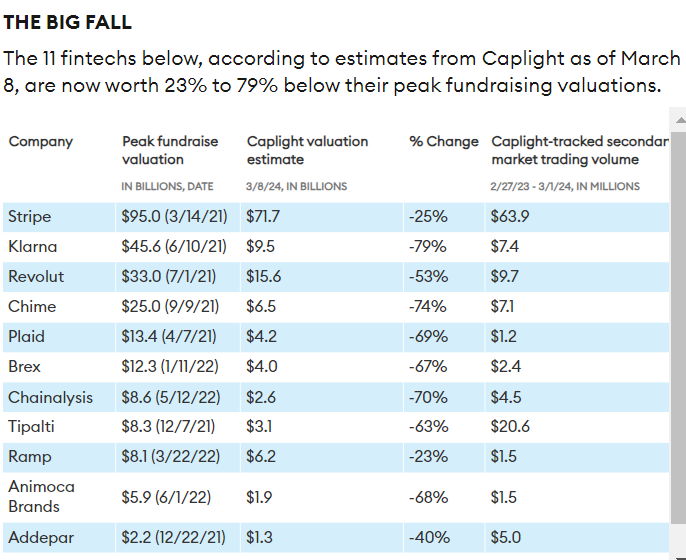|
The current estimated value of 11 leading private fintech startups shows declines as high as 79%. But a few have started to recover. Back in November 2021, as the market for venture capital funding of fintech companies was peaking, San Francisco Bay Area bill-payment startup Tipalti raised $270 million at an $8.3 billion valuation. Then last summer, shares in the company traded hands privately at a $4 billion value. Today, by one estimate, Tipalti is worth just $3.1 billion, down 63% from its peak, even though it has been growing smartly—to 3,500 mostly U.S.-based business customers now, up from 2,000 at the end of 2021. Chen Amit, Tipalti’s 58-year-old Israeli cofounder and CEO, considers $3 billion way too low, but he acknowledges that the inflated valuations of 2021 are history. “We just need to accept it. There's no need to fight it,” Amit says, pointing to other private fintech companies, such as Stripe and Klarna, that have raised money since then in down rounds. He adds: “I will not sell my shares at $3 billion. I doubt any knowledgeable person would.” The extraordinary boom and bust in venture capital funding for the fintech industry has left a puzzle in its wake: what are these startups really worth today? With VC dollars flowing to the industry plunging from $141 billion in 2021 to $39 billion globally in 2023, according to CB Insights, many startups have scrambled to conserve cash to avoid raising funds at a dramatically reduced valuation. Meanwhile, those further along the growth path have delayed initial public offerings as already-public fintechs are languishing, off about 50% from their peak, despite the S&P 500 and the tech-heavy Nasdaq recently setting new highs. All that has left a void of information—one now being filled by new platforms like Caplight and Notice that generate valuation estimates based on the secondary-market trades they track through their partnerships with brokers. These estimates may also incorporate public disclosures of markdowns taken by mutual funds holding shares in private companies, the prices of comparable publicly traded stocks and other data. Soon after Tipalti’s 2021 fundraise, stocks started tanking and the Federal Reserve began raising interest rates. Amit made aggressive moves to prepare the company for leaner times, laying off 11% of employees. “We knew we had fat in the organization,” he says. While the company maintains sizable staff in Israel, San Francisco and Vancouver, when it started hiring again, it emphasized lower-cost locations like Tbilisi, Georgia. And Tipalti continued to grow–it now processes about $5 billion in monthly payments, up from $3 billion at the time of its 2021 fundraise. (The company says it retains 99% of its customers each year.) So what’s Tipalti worth now? In the summer of 2023, a Tipalti shareholder sold about $20 million worth of stock on the secondary market at a $4 billion valuation, according to Oren Zeev, a venture capitalist and Tipalti cofounder. In the fourth quarter of 2023, Capital Group, one of the largest mutual fund companies in the world, marked its shares at $3.7 billion. Now Caplight, a San Francisco startup that both tracks secondary-market trades of private tech companies and provides a venue to trade shares, estimates Tipalti’s value at just $3.1 billion–a number that also takes account of the stock slump of several of Tipalti’s competitors including publicly traded Bill, which is off 80% since its late 2021 peak. Caplight shared with Forbes its valuations for a long list of fintechs it tracks. The chart below shows its estimates, as of March 8, for 11 of them–all sizable startups where private trades and other information available within the past year provide a foundation for those valuations. Of course, these are still just estimates. As befits a burst bubble, some of the declines in value from their fundraising peak valuation are dramatic–an estimated 79% for Klarna and 74% for Chime. Many of the companies, which were all given a chance by Forbes to comment on these values, pushed back, and you can see their responses in the company write-ups at the bottom of this story.
0 Comments
|
AuthorPeter Oakes is the primary author and curator of this page. We welcome others, and you will be fully and fairly credited in your contribution. Archives
April 2024
Categories
All
|


 RSS Feed
RSS Feed

